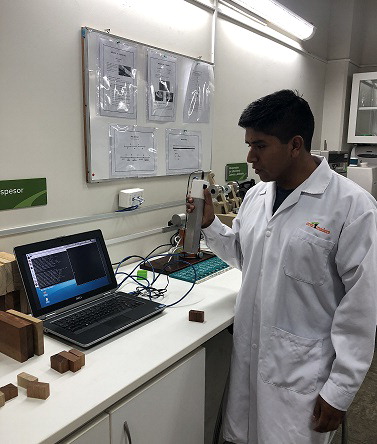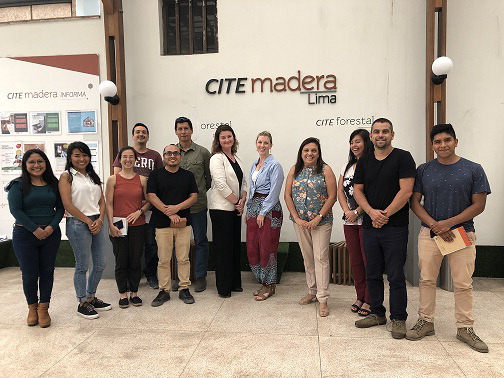|
Cycle 8 (2019 Deadline)
A wood species identification tool to aid in compliance and enforcement of Peruvian timber regulations
PI: José Ugarte Oliva (jugarte@itp.gob.pe), Instituto Tecnológico de la Producción - CITEmadera
U.S. Partner: Michael Wiemann, U.S. Forest Service, Forest Products Laboratory
Project Dates: January 2020 - December 2021
Project Overview:
 | | A member of Dr. Ugarte’s project team demonstrates the use of the XyloTron in identifying a wood sample. |
Illegal harvesting of trees ranks third in international crimes, causes up to 70 percent of deforestation, and costs billions of dollars in lost revenue annually (WWF, 2019), and Peru has been severely impacted. Many of the traded woods are high value species that are considered endangered by the Peruvian government (Resolución Ministerial Nº 0505 – 2016 – MINAGRI, 2016). In the case of Cedrela odorata and Swietenia macrophylla, they also are already included in Appendix II of the Convention on International Trade in Endangered Species of Wild Fauna and Flora (CITES). Law enforcement agencies have been mandated to develop strategies that curb this activity, but the ability to identify species accurately is limited to a few specialists worldwide. This situation is amplified in Peru due to the large number of commercial species, giving rise to a need for regulators to be familiar with the diverse anatomical characteristics and the numerous species that look similar. Species identification has been reported to be the limiting factor in enforcing compliance with national and international laws regarding the legal harvesting of timber. Training in wood identification and the development of tools to aid in wood species identification are needed by an expanding international community within public and private organizations. Therefore, the aim of this PEER project is to empower Peruvians in the enforcement of Peruvian environmental laws by implementing a field-deployable wood identification machine vision technology, XyloTron. The Wood Technological Innovation Center (CITEmadera), a government entity linked to the Technological Institute of Production (ITP) and a partner in the Peruvian timber sector, will be responsible for executing this project. The U.S. and external partners will consult on the acquisition and curation of the botanical samples, production of XyloTrons in Peru, and model building for the new species in the machine learning classifier. They will also provide assistance during field deployment.
The implementation of the XyloTron identification system for the 15 most important Peruvian tropical timbers should have many positive impacts in the forestry sector of Peru. The country is going through a difficult period due to conflicts between trade and forest resources conservation, and monitoring and enforcement operations for illegal timber need to be reinforced. Enforcement tasks are concentrated primarily at 40 active control points and the exportation ports, where the timber is inspected, with species identification being a key element. However, wood identification requires much knowledge and expertise, and neither Peru nor the rest of the world have enough of the necessary specialists to meet these needs. This PEER project will implement the XyloTron system as the key to improving the capability of wood identification at control points and ensuring legal harvest and trade. As part of the project objectives, CITEmadera will also transfer this technology to Peruvian government institutions responsible for the control of illegal timber so that they can test its effectiveness and integrate it in their workflow. In addition, the equipment of the XyloTron system will be available for further investigations of Peruvian wood species, and the PEER team will provide the necessary training. All of these actions should help Peru better manage its legacy of precious wood and contribute to the global effort to combat the illegal timber harvest.
Final Summary of Project Activities:
 | | PI Dr. José Ugarte (second from right) and his team welcome Lina Stankute-Alexander of NAS and Dr. Lily Sweikert (facing one another at center) during their visit to CITEmadera in January 2020. |
Working in close cooperation with the National Forestry and Wildlife Service of Peru (SERFOR) and forestry companies in the regions of Huánuco, Ucayali, and Loreto, PEER team members completed a carefully planned field sampling program, collecting 274 wood slices and associated botanical samples from 103 trees. The collection activities involved allied research centers such as CITEforestal-Maynas and CITEforestal-Pucallpa, which supported the development of the project and with whom relevant information on research with commercial forest species is usually exchanged, so the large number of samples collected can be used as a reference for identification in these centers for other future research projects. The botanical identification of the tree samples collected yielded a total of 35 species, many more than the initially planned 15-20 species. All the botanical samples were deposited in Scientific Depository Institutions of Biological Material authorized by SERFOR, who carried out the identification up to the species level. This identification not only served the purposes of the project but also to discuss the identification of species by the forestry companies where the collections were made. Many samples were obtained from this process, some were stored to be added to the database later and others were shared with other research centers, universities, and various research projects, to contribute to scientific research studies and for the implementation of wood samples that help with the identification of forest species in other regions. The identifications support by the project using both botanical and digital imaging methods will serve to verify and correct the identification made by the forestry companies since there is a notable difference between the records of these companies and the identification obtained through the project, adding in many cases up to three species of the same genus that were registered under the same scientific name by the companies.
From the raw wood samples collected in the field, the research team specially sized and smoothed almost 6,700 samples and then imaged them using the Xylotron system, which includes a laptop and a Xyloscope device, which has a camera and a special lens. All the prepared samples were coded to order the process allow for tracing each sample by origin and location of the trees from which they were collected. The images were then added to the Xylotron database for further analysis. In addition to using Xyloscopes donated to the project by the U.S. Forest Service (USFS), the team also built their own device using parts and instructions provided by the system’s developer, Dr. John Hermanson. The methodology used to replicate this device was recorded for inclusion in an illustrative manual that can be used and shared for future replications. The new models created for species identification made it possible to perform internal validation (laboratory tests) of the Xylotron system, which was done with the wood samples used for the project, on their prepared and unprepared surfaces. In this way, it was possible to cover the different forms in which wood is found in the field. The laboratory tests were important because they allowed the team, working in remote collaboration with Dr. Hermanson, to quickly verify the effectiveness of the Xylotron system for species identification, and with these results, they were able to suggest some improvements or updates for some species in the system, before carrying out identification tests in the field. These tests were carried out at the Pucusana (South), Corcona (East), and Ancon (North) checkpoints, important and nearby locations where there is a continuous traffic of various forest resources, including timber of different species, which is often seized or confiscated because it does not have the corresponding documentation or is of illegal origin. This timber is stored in warehouses, and it is precisely there where the field tests were carried out. The PEER team trained the personnel in charge of species identification at each checkpoint, from the explanation of the Xylotron system to the demonstration and operation with the participation of the staff members who will be responsible for applying this system in the future.
After the training workshops and field tests carried out at the ATFFS-Lima checkpoints, those involved expressed interest in using the Xylotron system as a tool to enhance their activities related to wood cargo inspection, evaluation, and identification. In this regard, SERFOR has accepted the donation of three Xylotron kits (laptop + Xyloscope) from USFS. This approach to new technology in the identification of species will allow the checkpoints to have support when corroborating the information of the Transport Guides (GTF) and verify the legality of the wood. A fourth donated Xylotron kit will remain at CITEmadera to continue facilitating wood sample imaging and technology transfer to control entities and to support the construction of the reference database of Peruvian species in the Xylotron System.
The project fit well with the aims of PEER Cycle 8, which was intended to support projects taking the “last mile” to practical implementation. Following are several key outputs and impacts:
- Donation of four Xylotron devices to Peruvian agencies (three to SERFOR and one to CITEmadera) as noted above
- Enhanced collaboration with Peruvian forestry companies, providing with guidance on species identification and linkages with regional herbaria that can reinforce their forest management knowledge and practices
- Improvement in the operation of the Xylotron system for species important in Peru
- Creation of four detailed protocols and six technical reports on various aspects of wood sampling, sample processing, imaging, and application of the Xylotron system for wood identification
Although the project has been completed, the researchers plan to continue and expand their collaborations: with USFS, SERFOR, German Society for International Cooperation in Peru (GIZ), World Wildlife Fund-Peru, and Continental University, the United Nations Office on Drugs and Crime in Peru, and La Molina National Agrarian University of Peru.
Back to PEER Cycle 8 Grant Recipients
|
|
|
|





